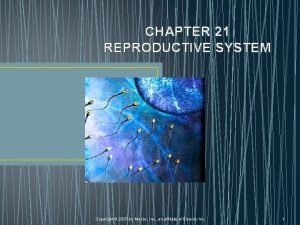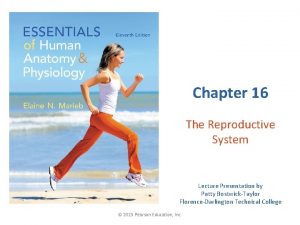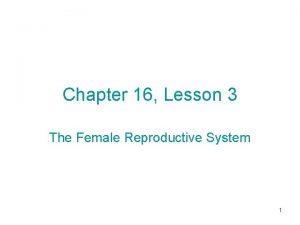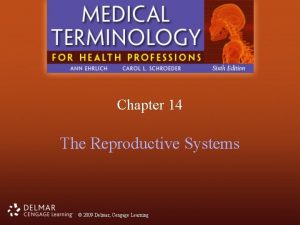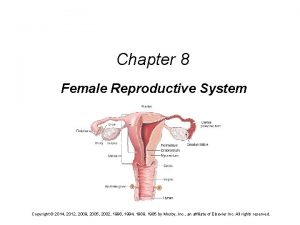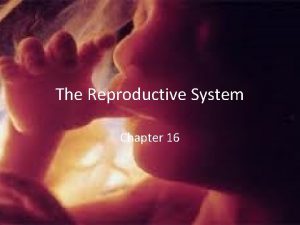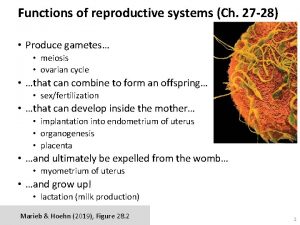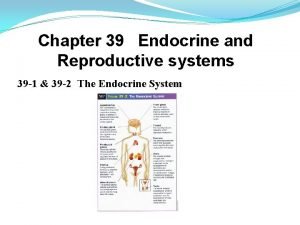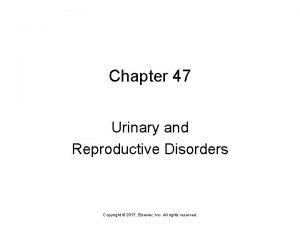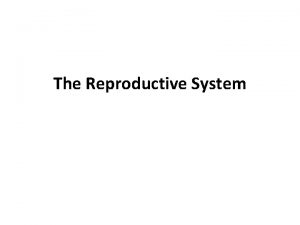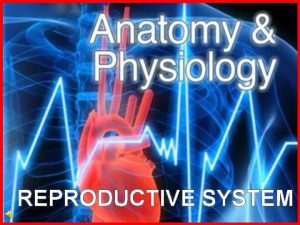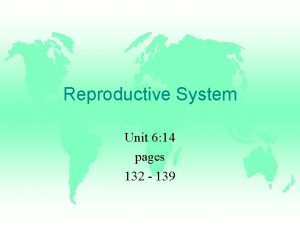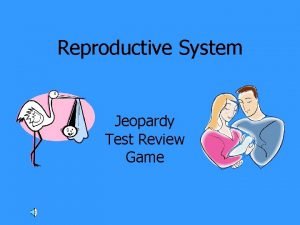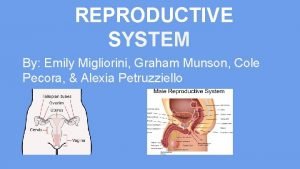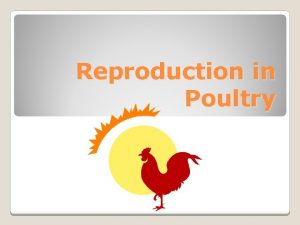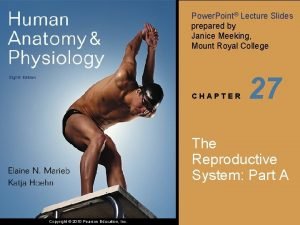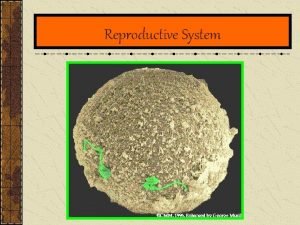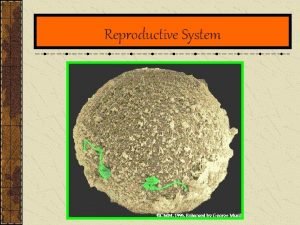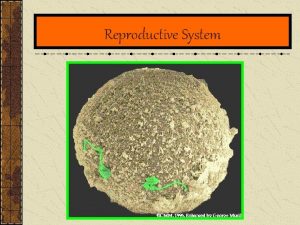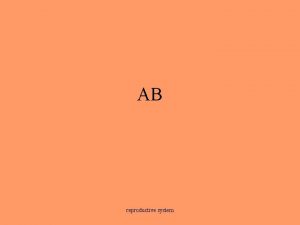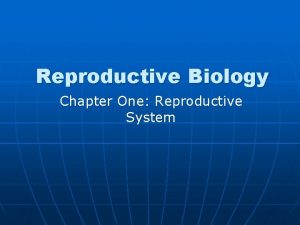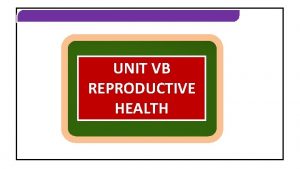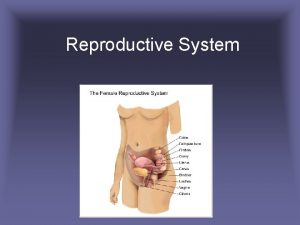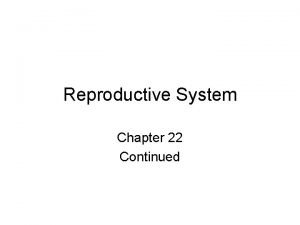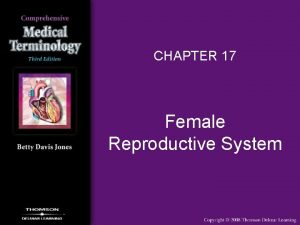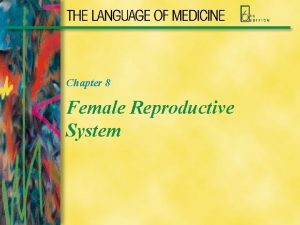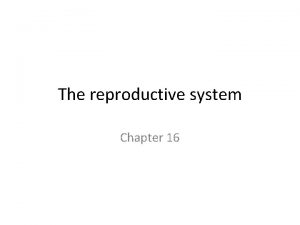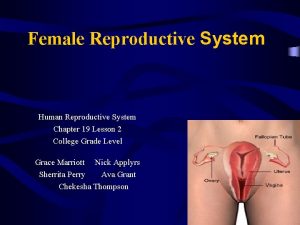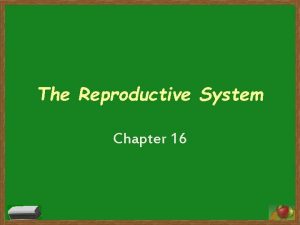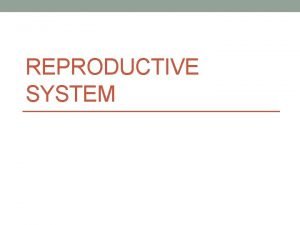The Reproductive System Chapter 16 The Reproductive System












































































- Slides: 76

The Reproductive System Chapter 16

The Reproductive System n Gonads – primary sex organs Testes in males n Ovaries in females n n Gonads produce gametes (sex cells) and secrete hormones Sperm – male gametes n Ova (eggs) – female gametes n

Male Reproductive System Consists of: n Testes n Duct system n Epididymis n Ductus deferens n Urethra n

Male Reproductive System n Accessory organs Seminal vesicle n Prostate gland n Bulbourethral gland n n External genitalia Penis n Scrotum n

Testes n Each testis is approx. 4 cm long and 2. 5 cm wide n Coverings of testes n Tunica albuginea n Fibrous connective tissue capsule that surrounds each testis Septa – n extensions of the capsule that extend into the testis and divide it into lobules n

n Each lobule contains one to four seminiferous tubules n Tightly coiled structures n Function as spermforming factories n Empty sperm into the rete testis (first part of the duct system) n Sperm travels through the rete testis to the epididymis n Interstitial cells in the seminiferous tubules produce androgens such as testosterone Testes

Duct System n Epididymis n Ductus (vas) deferens n Urethra

n Comma-shaped, tightly coiled tube n Location: n Found on the superior part of the testis and along the posterior lateral side n Function n To mature and store sperm cells (at least 20 days) n Expels sperm with the contraction of muscles in Epididymis

Ductus Deferens (Vas Deferens) n Carries sperm from the epididymis to the ejaculatory duct n Passes over the bladder n Moves sperm by peristalsis n Ends in the ejaculatory duct which unites with the urethra n Expanded end is called the ampulla n Vasectomy : n cutting of the ductus deferens at the level of the testes to prevent transportation of sperm

Urethra n Extends from the base of the urinary bladder to the tip of the penis n Carries both urine and sperm n Sperm enters from the ejaculatory duct

Urethra n Regions of the urethra n Prostatic urethra – surrounded by prostate n Membranous urethra – from prostatic urethra to penis n Spongy (penile) urethra – runs the length of the penis

Accessory Organs n Seminal vesicles n Prostate n Bulbourethral glands

Seminal Vesicles n Located at the base of the bladder n Produces a thick, yellowish secretion (60% of semen) n n Fructose (sugar) Vitamin C Prostaglandins Other substances that nourish and activate sperm

Prostate Gland n Encircles the upper part of the urethra n Secretes a milky fluid Helps to activate sperm n Enters the urethra through several small ducts n

Bulbourethral Glands n n Pea-sized gland inferior to the prostate Produces a thick, clear mucus Cleanses the urethra of acidic urine n Serves as a lubricant during sexual intercourse n Secreted into the penile urethra n

Semen n Mixture of sperm and accessory gland secretions of n Seminal vesicle n Prostate gland n Bulbourethral gland n Advantages of accessory gland secretions n Fructose provides energy for sperm cells n Alkalinity of semen helps neutralize the acidic environment of vagina n Semen contains seminalplasmin, an antibiotic chemical that inhibits bacterial multiplication n Semen releases hormones and enzymes that enhance sperm motility

External Genitalia n Scrotum n Penis

External Genitalia n Scrotum n Is a divided sac of skin hangs outside the abdomen between legs and at the root of the penis n Maintains testes at 3°C lower than normal body temperature to protect sperm viability

n Penis n n External Genitalia Delivers sperm into the female reproductive tract Regions of the penis Shaft n Glans penis (enlarged tip) n Prepuce (foreskin) n n Folded cuff of skin around proximal end n Often removed by

Produce sperm • And Testosterone hormone • Spermatogenesi s n Production of sperm cells n Begins at puberty and continues throughout life n Occurs in the seminiferous tubules

Processes of Spermatogenesis n Spermatogonia (stem cells) in outer edge of seminiferous tubules of testes undergo n rapid mitosis to produce more stem cells before puberty n During puberty, Follicle stimulating hormone (FSH) modifies spermatogonia division n One cell produced is a stem cell, called a type A daughter cell, maintain the stem cell population

n Processes of Spermatogenesis The other cell produced becomes a primary spermatocyte, called a type B daughter cell n Primary spermatocytes undergo meiosis n One primary spermatocyte produces four haploid spermatids n Spermatids— 23 chromosomes (half as much material as other body cells)

Human Life Cycle n Union of a sperm (23 chromosomes) with an egg (23 chromosomes) creates a zygote (2 n or 46 chromosomes)

Spermiogenesis n Late spermatids are produced with distinct regions n Head n Midpiece n Tail n n Sperm cells result after maturing of spermatids Spermatogenesis takes 64 to 72 days

Anatomy of a Mature Sperm Cell n n The only human flagellated cell Head n n Contains DNA Acrosome—“helmet” on the nucleus, similar to a large lysosome Breaks down and releases enzymes to help the sperm penetrate an egg Midpiece n Wrapped by mitochondria for ATP generation needed for the movement of tail

Testosterone Production n n The most important hormone of the testes During puberty, luteinizing hormone (LH) activate the interstitial cells And testosterone is produced in interstitial cells Functions of testosterone n Stimulates reproductive organ development n Underlies sex drive n Causes secondary sex characteristics n Deepening of voice n Increased hair growth n Enlargement of skeletal muscles n Thickening of bones

Hormonal Control of the Testis

Female Reproductive System Ovaries n Duct System n Uterine tubes (fallopian tubes) n Uterus n Vagina n n External genitalia

Ovaries n Composed of ovarian follicles (sac-like structures) n Structure of an ovarian follicle n Oocyte (immature egg) n Follicular cells — surround the oocyte

Ovarian Follicle Stages n Primary follicle – contains an immature oocyte n Graafian (vesicular) follicle – growing follicle with a maturing oocyte n Ovulation – n when the egg is mature the follicle ruptures n Occurs about every 28 days n The ruptured follicle is transformed into a corpus luteum which eventually degenerates

Support for Ovaries n n n Suspensory ligaments – secure ovary to lateral walls of the pelvis Ovarian ligaments – attach to uterus Broad ligament – a fold of the peritoneum, encloses suspensory ligament

Uterine (Fallopian) Tubes n n n Receive the ovulated oocyte Provide a site for fertilization Attaches to the uterus Does not physically attach to the ovary Supported by the broad ligament

n n n Uterine Tube Function Fimbriae n Finger-like projections at the distal end of the uterine tube n Receive the oocyte from the ovary Cilia n Located inside the uterine tube n Slowly move the oocyte towards the uterus (takes 3– 4 days) Fertilization occurs inside the uterine tube since oocyte lives about 24 hours

Uterus n n n Located between the urinary bladder and rectum Hollow organ Functions of the uterus n Receives a fertilized egg n Retains the fertilized egg n Nourishes the fertilized egg

Support for the Uterus n n n Broad ligament – attached to the pelvis Round ligament – anchored interiorly Uterosacral ligaments – anchored posteriorly

Regions of the Uterus n n n Body – main portion Fundus – area where uterine tube enters Cervix – narrow outlet that protrudes into the vagina

Walls of the Uterus n Endometrium: Inner layer n Allows for implantation of a fertilized egg n Sloughs off if no pregnancy occurs (menses) n Myometrium – middle layer of smooth muscle Serous layer – outer visceral peritoneum n

Vagina n n n Extends from cervix to exterior of body Behind bladder and in front of rectum Serves as the birth canal Receives the penis during sexual intercourse Hymen – partially closes the vagina until it is ruptured

External Genitalia (Vulva) n Mons Pubis n n n Fatty area overlying the pubic symphysis Covered with pubic hair after puberty Labia – skin folds n n Labia majora— haircovered skin folds Labia minora— delicate, hair-free folds of skin

n External Genitalia Vestibule n Enclosed by labia majora n Contains external openings of the urethra, followed by vagina n Greater vestibular glands n One is found on each side of the vagina n Secretes lubricant during intercourse n Clitoris n Contains erectile tissue n Corresponds to the

Oogenesis n n The total supply of eggs are present at birth Ability to release eggs begins at puberty Reproductive ability ends at menopause Oocytes are matured in developing ovarian follicles

Oogenesis n Oogonia – female stem cells found in a developing fetus n Oogonia undergo mitosis to produce primary oocytes n Primary oocytes are surrounded by cells that form primary follicles in the ovary n Oogonia no longer exist by the time of birth

Oogenesis n n Primary oocytes are inactive until puberty Follicle stimulating hormone (FSH) causes some primary follicles to mature each month n Meiosis starts inside maturing follicle n Produces a secondary oocyte and the first polar body

Oogenesis Meiosis is completed after ovulation only n if sperm penetrates n ovum is produced n Two additional polar bodies are produced Once ovum is formed, the 23 chromosomes can be combined with those of the sperm to form the fertilized egg (zygote) If the secondary oocyte is not penetrated by a sperm, it dies and does not complete meiosis to form an ovum n n n

Male and Female Differences n Meiosis Males— produces four functional sperm n Females— produces one functional ovum and three polar bodies n n Sex cell size and structure Sperm are tiny, motile, and equipped with nutrients in seminal fluid n Egg is large, non-motile, and has nutrient reserves to nourish the embryo until implantation n

Uterine (Menstrual) Cycle Cyclic changes of the endometrium n Regulated by cyclic production of estrogens and progesterone n FSH and LH regulate the production of estrogens and progesterone n Both female cycles are about 28 days in length n Ovulation typically occurs about midway through cycle on day 14 n

Uterine (Menstrual) Cycle n Stages of the menstrual cycle n n n Menstrual phase Proliferative stage Secretory stage

Uterine (Menstrual) Cycle n Menstrual phase Days 1– 5 n Functional layer of the endometrium is sloughed n Bleeding occurs for 3– 5 days n By day 5, growing ovarian follicles are producing more estrogen n

Uterine (Menstrual) Cycle n Proliferative stage Days 6– 14 n Regeneration of functional layer of the endometrium n Estrogen levels rise n Ovulation occurs in the ovary at the end of this stage n

Uterine (Menstrual) Cycle n Secretory stage n Days 15– 28 n Levels of progesterone rise and increase the blood supply to the endometrium n Endometrium increases in size and begin secreting nutrients into the uterine cavity and sustain a developing embryo n If fertilization does occur n Embryo produces a hormone that causes the corpus luteum to continue producing its hormones n If fertilization does NOT occur n Corpus luteum degenerates as LH blood levels decline n Endometrial cells die n Sets the stage for menses again on day 28

Hormonal Control of the Ovarian and Uterine Cycles

Hormone Production by the Ovaries n Estrogens n n Produced by follicle cells Cause secondary sex characteristics n n n Enlargement of accessory organs Development of breasts Appearance of pubic hair Increase in fat beneath the skin Widening and lightening of the pelvis Onset of menses

Hormone Production by the Ovaries n Progesterone n n Produced by the corpus luteum Production continues until LH diminishes in the blood Does not contribute to the appearance of secondary sex characteristics Other major effects n n Helps maintain pregnancy Prepare the breasts for milk production

Mammary Glands n Present in both sexes, but only function in females n Modified sweat glands Function is to produce milk n Stimulated by sex hormones (mostly estrogens) to increase in size n

Anatomy of Mammary Glands n Areola – central pigmented area n Nipple – protruding central area of areola n Lobes – internal structures that radiate around nipple n Alveolar glands – clusters of milk producing glands within lobules n Lactiferous ducts – connect alveolar glands to nipple

Stages of Pregnancy and Development Fertilization n Embryonic development n Fetal development n Childbirth n

Fertilization n The oocyte is viable for 12 to 24 hours after ovulation Sperm are viable for 12 to 48 hours after ejaculation Sperm cells must make their way to the uterine tube for fertilization to be possible

Mechanisms of Fertilization n n Membrane receptors on an oocyte pulls the n head of the first sperm cell to make contact n The membrane of the oocyte does not permit a second sperm head to enter n The oocyte then undergoes its second meiotic division Fertilization occurs n when the genetic material of a sperm combines with that of an oocyte to form a zygote

The Zygote n First cell of a new individual n The result of the fusion of DNA from sperm and egg n The zygote begins rapid mitotic cell divisions n The zygote stage is in the uterine tube,

The Embryo n n n Developmental stage from the start of cleavage until the ninth week The embryo first undergoes division without growth The embryo enters the uterus at the 16 -cell state (called morula) The embryo floats free in the uterus temporarily Uterine secretions are used for nourishment

The Blastocyst n n n Ball-like circle of cells Begins at about the 100 cell stage Secretes human chorionic gonadotropin (h. CG) to n n n produce the corpus luteum to continue producing Hormones progesterone and estrogen Functional areas of the blastocyst n Trophoblast – large fluid-filled sphere

The Blastocyst n n Primary germ layers are eventually formed n Ectoderm – outside layer n Mesoderm – middle layer n Endoderm – inside layer The late blastocyst implants in the wall of the uterus (by day 14)

Derivatives of Germ Layers n Ectoderm Nervous system n Epidermis of the skin n n Endoderm Mucosae n Glands n n Mesoderm n Everything else

Development After Implantation • Chorionic villi (projections of the blastocyst) develop • Cooperate with cells of the uterus to form the placenta • The embryo is surrounded by the amnion (a fluid filled sac) • An umbilical cord forms to attach the embryo to the placenta

Functions of the Placenta n Forms a barrier between mother and embryo (blood is not exchanged) n Delivers nutrients and oxygen n Removes waste from embryonic blood n Becomes an endocrine organ (produces hormones) and takes over for the corpus luteum by producing n Estrogen n Progesterone n Other hormones that maintain pregnancy

The Fetus (Beginning of the Ninth Week) n All organ systems are formed by the end of the eighth week n Activities of the fetus are n growth and organ specialization n change in appearance


The Effects of Pregnancy on the Mother n Pregnancy – period from conception until birth n Anatomical changes n n n Enlargements of the uterus Accentuated lumbar curvature Relaxation of n the pelvic ligaments n and pubic symphysis n due to production of

Effects of Pregnancy on the Mother n Physiological n changes Gastrointestinal system n n n Morning sickness is common due to elevated progesterone Heartburn is common because of organ crowding by the fetus Constipation is caused by declining motility of the digestive tract n Urinary System n Kidneys have additional burden and produce more urine n The uterus compresses the bladder

Effects of Pregnancy on the Mother n Respiratory System n Nasal mucosa becomes congested and swollen n Vital capacity and respiratory rate increase n Cardiovascular system n Body water rises n Blood volume increases by 25 to 40 percent n Blood pressure and pulse increase n Varicose veins are common

Childbirth (Partition) n Labor – the series of events that expel the infant from the uterus n Initiation of labor n n n Estrogen levels rise Uterine contractions begin The placenta releases prostaglandins Oxytocin is released by the pituitary Combination of these hormones produces contractions

Stages of Labor n Dilation n n Expulsion n Cervix becomes dilated Uterine contractions begin and increase The amnion ruptures (breaking the water) Infant passes through the cervix and vagina Normal delivery is head first Placental stage n Delivery of the placenta

Stages of Labor

Developmental Aspects of the Reproductive System n Gender is determined at fertilization Males have XY sex chromosomes n Females have XX sex chromosomes n n Gonads do not begin to form until the eighth week n Testosterone determines whether male or female structures will form

Developmental Aspects of the Reproductive System Reproductive system organs do not function until puberty n Puberty usually begins between ages 10 and 15 n Males n n n Enlargement of testes and scrotum signals onset of puberty (often around age 13) Females n Budding breasts signal puberty (often around age 11)

Developmental Aspects of the Reproductive System n n n The first menses usually occurs about two years after the start of puberty Most women reach peak reproductive ability in their late 20 s Menopause occurs when ovulation and menses cease entirely n n Ovaries stop functioning as endocrine organs There is a no equivalent of menopause in males, but there is a steady decline in testosterone
 The reproductive system chapter 16
The reproductive system chapter 16 Chapter 21 reproductive system
Chapter 21 reproductive system Chapter 17 reproductive system diseases and disorders
Chapter 17 reproductive system diseases and disorders Chapter 16 the reproductive system figure 16-2
Chapter 16 the reproductive system figure 16-2 Chapter 16 the reproductive system
Chapter 16 the reproductive system Chapter 7:14 reproductive system
Chapter 7:14 reproductive system Chapter 8 female reproductive system
Chapter 8 female reproductive system The reproductive system chapter 16
The reproductive system chapter 16 Chapter 16 lesson 3 the female reproductive system
Chapter 16 lesson 3 the female reproductive system Parts of and functions of female reproductive system
Parts of and functions of female reproductive system Hhmi biointeractive sex verification testing of athletes
Hhmi biointeractive sex verification testing of athletes Structure of female
Structure of female Endocrine system and reproductive system
Endocrine system and reproductive system Chapter 39 endocrine and reproductive systems
Chapter 39 endocrine and reproductive systems Ovulation animation
Ovulation animation Chapter 2 human reproductive anatomy and physiology
Chapter 2 human reproductive anatomy and physiology Chapter 47 urinary and reproductive disorders
Chapter 47 urinary and reproductive disorders Hát kết hợp bộ gõ cơ thể
Hát kết hợp bộ gõ cơ thể Slidetodoc
Slidetodoc Bổ thể
Bổ thể Tỉ lệ cơ thể trẻ em
Tỉ lệ cơ thể trẻ em Chó sói
Chó sói Glasgow thang điểm
Glasgow thang điểm Chúa yêu trần thế alleluia
Chúa yêu trần thế alleluia Các môn thể thao bắt đầu bằng tiếng bóng
Các môn thể thao bắt đầu bằng tiếng bóng Thế nào là hệ số cao nhất
Thế nào là hệ số cao nhất Các châu lục và đại dương trên thế giới
Các châu lục và đại dương trên thế giới Công thức tính thế năng
Công thức tính thế năng Trời xanh đây là của chúng ta thể thơ
Trời xanh đây là của chúng ta thể thơ Cách giải mật thư tọa độ
Cách giải mật thư tọa độ 101012 bằng
101012 bằng độ dài liên kết
độ dài liên kết Các châu lục và đại dương trên thế giới
Các châu lục và đại dương trên thế giới Thể thơ truyền thống
Thể thơ truyền thống Quá trình desamine hóa có thể tạo ra
Quá trình desamine hóa có thể tạo ra Một số thể thơ truyền thống
Một số thể thơ truyền thống Cái miệng bé xinh thế chỉ nói điều hay thôi
Cái miệng bé xinh thế chỉ nói điều hay thôi Vẽ hình chiếu vuông góc của vật thể sau
Vẽ hình chiếu vuông góc của vật thể sau Nguyên nhân của sự mỏi cơ sinh 8
Nguyên nhân của sự mỏi cơ sinh 8 đặc điểm cơ thể của người tối cổ
đặc điểm cơ thể của người tối cổ Thứ tự các dấu thăng giáng ở hóa biểu
Thứ tự các dấu thăng giáng ở hóa biểu Vẽ hình chiếu đứng bằng cạnh của vật thể
Vẽ hình chiếu đứng bằng cạnh của vật thể Vẽ hình chiếu vuông góc của vật thể sau
Vẽ hình chiếu vuông góc của vật thể sau Thẻ vin
Thẻ vin đại từ thay thế
đại từ thay thế điện thế nghỉ
điện thế nghỉ Tư thế ngồi viết
Tư thế ngồi viết Diễn thế sinh thái là
Diễn thế sinh thái là Các loại đột biến cấu trúc nhiễm sắc thể
Các loại đột biến cấu trúc nhiễm sắc thể Số nguyên tố là số gì
Số nguyên tố là số gì Tư thế ngồi viết
Tư thế ngồi viết Lời thề hippocrates
Lời thề hippocrates Thiếu nhi thế giới liên hoan
Thiếu nhi thế giới liên hoan ưu thế lai là gì
ưu thế lai là gì Sự nuôi và dạy con của hươu
Sự nuôi và dạy con của hươu Sự nuôi và dạy con của hươu
Sự nuôi và dạy con của hươu Hệ hô hấp
Hệ hô hấp Từ ngữ thể hiện lòng nhân hậu
Từ ngữ thể hiện lòng nhân hậu Thế nào là mạng điện lắp đặt kiểu nổi
Thế nào là mạng điện lắp đặt kiểu nổi Male reproductive system from front
Male reproductive system from front Male reproductive system and its function
Male reproductive system and its function Seminal tubules
Seminal tubules Female reproductive system with baby
Female reproductive system with baby Exercise 42 review male reproductive system
Exercise 42 review male reproductive system Ovarian structures
Ovarian structures Uterus layers histology
Uterus layers histology Epilization
Epilization Unit 6:14 reproductive system
Unit 6:14 reproductive system Broad ligament of uterus
Broad ligament of uterus Reproductive system jeopardy
Reproductive system jeopardy Female and male reproductive system
Female and male reproductive system Graham munson
Graham munson Reproductive physiology
Reproductive physiology Chicken uterus
Chicken uterus Male plant reproductive system
Male plant reproductive system Art-labeling activity: the male reproductive system, part 1
Art-labeling activity: the male reproductive system, part 1 Poultry reproductive system
Poultry reproductive system

